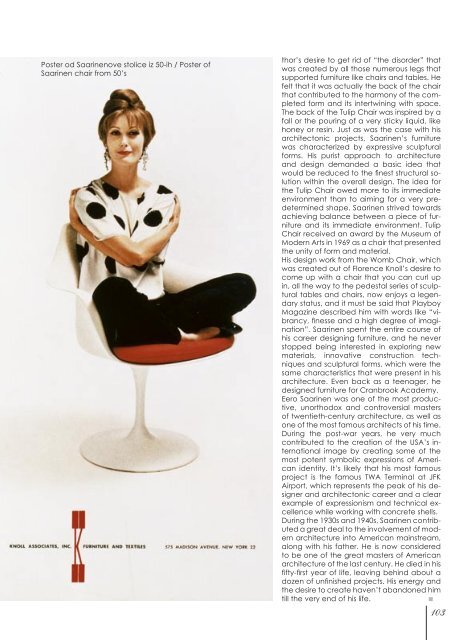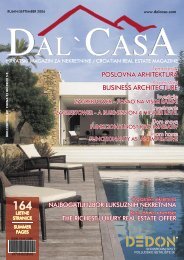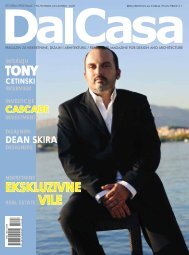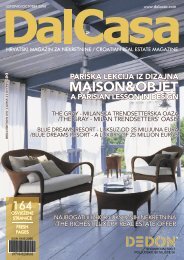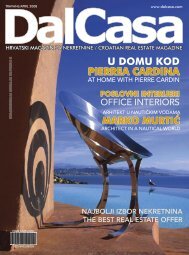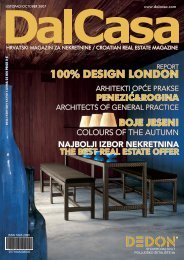saša šekoranja interijeri za zaljubljene - DalCasa
saša šekoranja interijeri za zaljubljene - DalCasa
saša šekoranja interijeri za zaljubljene - DalCasa
Create successful ePaper yourself
Turn your PDF publications into a flip-book with our unique Google optimized e-Paper software.
Poster od Saarinenove stolice iz 50-ih / Poster of<br />
Saarinen chair from 50’s<br />
thor’s desire to get rid of “the disorder” that<br />
was created by all those numerous legs that<br />
supported furniture like chairs and tables. He<br />
felt that it was actually the back of the chair<br />
that contributed to the harmony of the completed<br />
form and its intertwining with space.<br />
The back of the Tulip Chair was inspired by a<br />
fall or the pouring of a very sticky liquid, like<br />
honey or resin. Just as was the case with his<br />
architectonic projects, Saarinen’s furniture<br />
was characterized by expressive sculptural<br />
forms. His purist approach to architecture<br />
and design demanded a basic idea that<br />
would be reduced to the finest structural solution<br />
within the overall design. The idea for<br />
the Tulip Chair owed more to its immediate<br />
environment than to aiming for a very predetermined<br />
shape. Saarinen strived towards<br />
achieving balance between a piece of furniture<br />
and its immediate environment. Tulip<br />
Chair received an award by the Museum of<br />
Modern Arts in 1969 as a chair that presented<br />
the unity of form and material.<br />
His design work from the Womb Chair, which<br />
was created out of Florence Knoll’s desire to<br />
come up with a chair that you can curl up<br />
in, all the way to the pedestal series of sculptural<br />
tables and chairs, now enjoys a legendary<br />
status, and it must be said that Playboy<br />
Magazine described him with words like “vibrancy,<br />
finesse and a high degree of imagination”.<br />
Saarinen spent the entire course of<br />
his career designing furniture, and he never<br />
stopped being interested in exploring new<br />
materials, innovative construction techniques<br />
and sculptural forms, which were the<br />
same characteristics that were present in his<br />
architecture. Even back as a teenager, he<br />
designed furniture for Cranbrook Academy.<br />
Eero Saarinen was one of the most productive,<br />
unorthodox and controversial masters<br />
of twentieth-century architecture, as well as<br />
one of the most famous architects of his time.<br />
During the post-war years, he very much<br />
contributed to the creation of the USA’s international<br />
image by creating some of the<br />
most potent symbolic expressions of American<br />
identity. It’s likely that his most famous<br />
project is the famous TWA Terminal at JFK<br />
Airport, which represents the peak of his designer<br />
and architectonic career and a clear<br />
example of expressionism and technical excellence<br />
while working with concrete shells.<br />
During the 1930s and 1940s, Saarinen contributed<br />
a great deal to the involvement of modern<br />
architecture into American mainstream,<br />
along with his father. He is now considered<br />
to be one of the great masters of American<br />
architecture of the last century. He died in his<br />
fifty-first year of life, leaving behind about a<br />
dozen of unfinished projects. His energy and<br />
the desire to create haven’t abandoned him<br />
till the very end of his life.<br />
103


